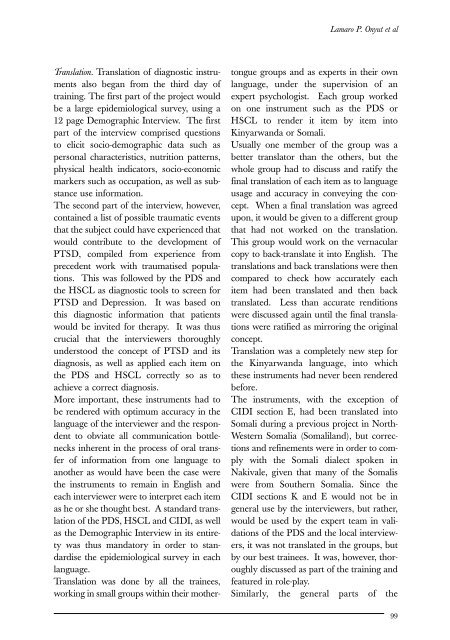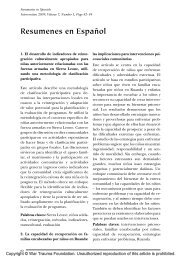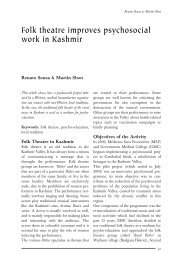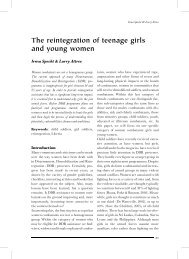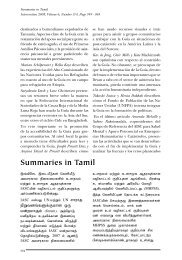The Nakivale Camp Mental Health Project: building local ...
The Nakivale Camp Mental Health Project: building local ...
The Nakivale Camp Mental Health Project: building local ...
Create successful ePaper yourself
Turn your PDF publications into a flip-book with our unique Google optimized e-Paper software.
Translation. Translation of diagnostic instruments<br />
also began from the third day of<br />
training. <strong>The</strong> first part of the project would<br />
be a large epidemiological survey, using a<br />
12 page Demographic Interview. <strong>The</strong> first<br />
part of the interview comprised questions<br />
to elicit socio-demographic data such as<br />
personal characteristics, nutrition patterns,<br />
physical health indicators, socio-economic<br />
markers such as occupation, as well as substance<br />
use information.<br />
<strong>The</strong> second part of the interview, however,<br />
contained a list of possible traumatic events<br />
that the subject could have experienced that<br />
would contribute to the development of<br />
PTSD, compiled from experience from<br />
precedent work with traumatised populations.<br />
This was followed by the PDS and<br />
the HSCL as diagnostic tools to screen for<br />
PTSD and Depression. It was based on<br />
this diagnostic information that patients<br />
would be invited for therapy. It was thus<br />
crucial that the interviewers thoroughly<br />
understood the concept of PTSD and its<br />
diagnosis, as well as applied each item on<br />
the PDS and HSCL correctly so as to<br />
achieve a correct diagnosis.<br />
More important, these instruments had to<br />
be rendered with optimum accuracy in the<br />
language of the interviewer and the respondent<br />
to obviate all communication bottlenecks<br />
inherent in the process of oral transfer<br />
of information from one language to<br />
another as would have been the case were<br />
the instruments to remain in English and<br />
each interviewer were to interpret each item<br />
as he or she thought best. A standard translation<br />
of the PDS, HSCL and CIDI, as well<br />
as the Demographic Interview in its entirety<br />
was thus mandatory in order to standardise<br />
the epidemiological survey in each<br />
language.<br />
Translation was done by all the trainees,<br />
working in small groups within their mother-<br />
Lamaro P. Onyut et al<br />
tongue groups and as experts in their own<br />
language, under the supervision of an<br />
expert psychologist. Each group worked<br />
on one instrument such as the PDS or<br />
HSCL to render it item by item into<br />
Kinyarwanda or Somali.<br />
Usually one member of the group was a<br />
better translator than the others, but the<br />
whole group had to discuss and ratify the<br />
final translation of each item as to language<br />
usage and accuracy in conveying the concept.<br />
When a final translation was agreed<br />
upon, it would be given to a different group<br />
that had not worked on the translation.<br />
This group would work on the vernacular<br />
copy to back-translate it into English. <strong>The</strong><br />
translations and back translations were then<br />
compared to check how accurately each<br />
item had been translated and then back<br />
translated. Less than accurate renditions<br />
were discussed again until the final translations<br />
were ratified as mirroring the original<br />
concept.<br />
Translation was a completely new step for<br />
the Kinyarwanda language, into which<br />
these instruments had never been rendered<br />
before.<br />
<strong>The</strong> instruments, with the exception of<br />
CIDI section E, had been translated into<br />
Somali during a previous project in North-<br />
Western Somalia (Somaliland), but corrections<br />
and refinements were in order to comply<br />
with the Somali dialect spoken in<br />
<strong>Nakivale</strong>, given that many of the Somalis<br />
were from Southern Somalia. Since the<br />
CIDI sections K and E would not be in<br />
general use by the interviewers, but rather,<br />
would be used by the expert team in validations<br />
of the PDS and the <strong>local</strong> interviewers,<br />
it was not translated in the groups, but<br />
by our best trainees. It was, however, thoroughly<br />
discussed as part of the training and<br />
featured in role-play.<br />
Similarly, the general parts of the<br />
99


